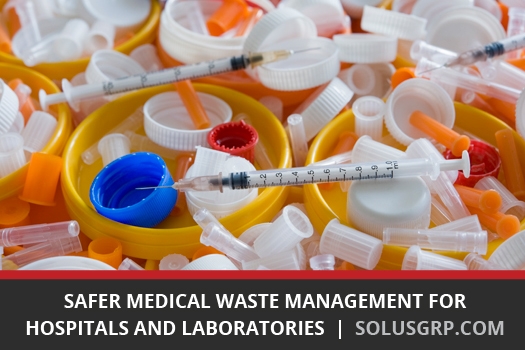We use cookies to make your experience better. To comply with the new e-Privacy directive, we need to ask for your consent to set the cookies. Learn more.
Safer Medical Waste Management for Hospitals and Laboratories
Hospitals and laboratories face complex challenges with safe medical waste management. Besides generating recycling, compost, and landfill garbage, these medical centers produce a more regulated type of trash generally called medical waste. This category includes:
- Syringes, needles, scalpels, and other sharps
- Pharmaceutical and chemical waste
- Radioactive substances
- Pathological tissues and infectious materials
- Genotoxic byproducts
Each category poses various threats, though all hazardous medical waste must be kept separate from landfill-bound trash. The health departments or environmental agencies of each state regulate the disposal of these distinct medical wastes. 
Safe handling starts where the waste is generated. Clearly labelled and color-coded bins help staff remember where each type of hazardous waste belongs. When it's time to empty the bins, even more care is needed. Experts urge hospitals to map the routes of medical waste and use special carts to transport bins.
Manually emptying bins can pose a safety risk for staff.
To eliminate the dangers posed by medical waste, hospitals use a variety of waste disposal methods such as incineration, chemical or radiation treatments, and autoclaves, which sterilize through heat, pressure, and steam. However, the simple act of emptying bins into disposal sites can be a major safety risk.
For instance, emptying sharps can result in needle-stick injuries that carry high risks of transmitting viruses like HIV, hepatitis B, and hepatitis C. There is a toxic exposure risk when handling antibiotics, cytotoxic drugs, mercury, or dioxins. To put it simply, those in charge of medical waste management must ensure that staff can empty bins without the possibility of exposure to hazardous waste.
Hydraulic bin dumpers eliminate both ergonomic and health risks to staff.
Bin Dumpers like the Dumpmaster are ideal for medical waste disposal due to their steady and high-capacity lift-and-tip action. Additionally, they can be customized with a variety of helpful features including:
- Splash shields that protect workers from dangerous liquids.
- An auto-cycle feature that allows staff to empty bins without being in the same room, which completely eliminates splashing dangers.
- Specialized cradles that allow tippers to empty any kind of container, from steel drums to square tubs.
- Stainless steel construction for easy cleaning and sterilization.
Bin Dumpers offer the versatility needed to safely empty all varieties of hazardous materials. They can be stored indoors or out and allow a staff member to safely load large volumes of waste into an incinerator or other disposal destination. These customizable waste dumpers provide all the crucial features that medical waste disposal demands.
References:
Alijabre, Salih. “Hospital Generated Waste: A Plan for Its Proper Management.” NIH. Journal of Family & Community Medicine, May-Aug, 2002. Web. 19 Feb. 2018.
"Health-care waste." WHO. World Health Organization, Feb. 2018. Web. 19 Feb. 2018.
“Non-Incineration Medical Waste Treatment Technologies.” NoHarm. Health Care Without Harm, Aug. 2001. PDF. 19 Feb. 2018.
